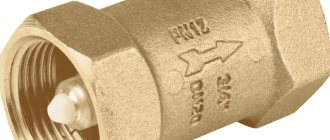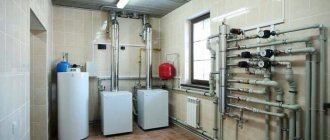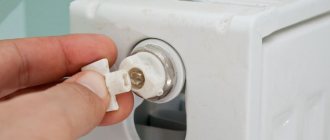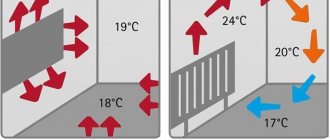Are solar systems in demand?
Already, more than 160 million m2 of these panels have been installed worldwide. China and Japan are leading. Some European countries are not lagging behind, where heat generation by such systems is about 5% of the total required.
Not many years will pass and many countries will abandon gas and coal completely. For example, in Ukraine, where tariffs are quite high, such systems are installed in large quantities. A one-time investment will allow you to achieve energy independence, even if only partial. And it’s not just about saving money, such installations are environmentally friendly and do not pollute the environment.
Advantages of these systems
There are now many alternative energy sources, including solar panels, wind generators, heat pumps, etc. However, it is solar collectors that are gaining increasing popularity, there are a number of reasons for this:
- The cost of the system is the lowest of all alternative sources
, this is due to the simple manufacturing and installation technology. - Simple installation
, which you can do even yourself if you have certain knowledge and skills. - Easy to use
, no special skills are needed to monitor them. - Low repair cost
, all system parts are inexpensive. There are no large components that require complete replacement. You can carry out the repair yourself, having first studied the device a little. - Versatility
. The solar system can be used for heating water and heating, without additional energy conversion cycles. You can select the number of panels based on their specific needs.
A little about the disadvantages
Any system has disadvantages and solar collectors are no exception.
They occupy a significant area, one panel takes up an average of 2-3 m2. The efficiency of their work depends on the climate zone where they are used. They are also very climate dependent; in winter their efficiency is minimal, while energy consumption for heating is maximum. This makes solar collectors not very efficient for heating. As many manufacturers claim, they are able to cover up to 30% of heating costs.
However, this is all relative. More panels and larger capacity storage tanks will increase this %. But, additional equipment will also increase the cost of the system.
DIY design
The design of solar installations is not so complex that people with some training would not be able to build and run them in their own homes. solar system for heating a 100 sq. m house is a completely feasible idea that will help you save significantly on purchases and repair work . Let's consider the possible options.
Thermosiphon solar system
Thermosiphon solar systems are tubular collectors , which were discussed above. There are non-pressure and pressure designs, differing in the way the coolant circulates. Non-pressure ones operate on the natural movement of liquid and do not require electricity; the composition of the complex is much simpler and cheaper. Pressure ones are able to provide a given circulation mode and allow for maximum efficiency. The most active operation of such systems is from April to October; the further north the region is, the shorter the period of greatest activity of the installations.
Air solar system
Air collectors are installations that use air as a coolant . They heat the house using the ventilation method, which allows you to seriously save on creating heating circuits and use the system all year round.
The collector is a hollow black box in which air is heated by solar heat . Warm air is directed into the room, and cooled air is sent to the collector for heating. To reduce heat loss, the box is installed in a transparent sealed container that protects from external influences - wind, low temperature, etc. The entrance and exit are placed in different rooms to increase the pressure difference and organize independent flow circulation.
Requirements for heating devices
A common misconception is the assumption that the use of solar energy to support a heating system is only possible for underfloor heating systems (warm floors). This assumption is wrong. The productivity of a solar system with radiator heating on average per year is only slightly less. The reason for this is the higher inlet temperature to the solar system, which is always determined by the heating circuit return temperature. When comparing different heating devices, it is necessary to keep in mind that during the transition period the thermal load of the heating system should be covered mainly by the solar system. However, at this time the heating devices do not operate in the design temperature range, and the return pipeline may have a lower temperature.
It is very important to ensure correct hydraulic equalization of the radiator heating circuits!
How to choose a solar installation
The choice of the type of solar installation and its power depends on the purpose for which it is intended and the area of residence: the number of sunny days per year and the minimum air temperature in winter. Since in our latitudes there are negative temperatures in winter, the best choice would be double-circuit installations with a coolant in the form of an antifreeze liquid.
If only hot water is supplied to the house using a solar system, then a smaller power installation and a correspondingly smaller solar collector area will be required. If the house is supposed to be heated using solar energy, then the power of the installation and the area of the collectors should be much larger. So, a solar collector area of 4-6 m2 will be enough to provide 50-70% of the hot water supply in the house. An area of 10-12 m2 should already be completely enough for hot water supply and partially for heating.
Full provision of thermal energy to a house is only possible if the solar collector area is more than 12 m2. Although this also depends on the size of the house itself and how effectively it is insulated. If, at some point, there is not enough solar energy for heating, for example, during a significant cold spell or absence of sunny weather, then for this purpose a backup boiler is connected in parallel to the heating circuit: electric, gas or another, depending on the availability of a particular type of fuel .
Installation and Orientation
Solar collectors on the roof of the house and in front of the pool
Solar collectors, depending on their type and area, can be installed both on the roof of the house and in an open area near the house, always on the south side. The angle of their inclination is also very important. The closer it is to the value of 90° in relation to the sun's rays, the better the coolant in them will heat up. The best option here would be systems with automatic tilt angle control. But such solar systems have a high cost. If the collectors are fixed, then they should be oriented to the south or as close to this direction as possible.
Payback period
The payback of solar systems depends both on their cost itself and on the price of traditional types of energy that are used for heating in a particular area. For Europe, where solar power plants are most popular, the payback period, on average, is up to 5 years. For central Russia, as well as neighboring countries, it will be at least twice as large. Although, given the constant rise in energy prices, over time it will decrease. At the same time, it is necessary to take into account that even using solar power plants as additional heating or for hot water supply, you can save from 40 to 70% of other, traditional types of fuel.
Video on the topic:
Operating principle and types of solar systems
The principle of their operation is based on heating the coolant by the sun's rays, which circulates in the solar collector and then feeds it into the storage tank, from where the heat is supplied to the heating or hot water supply system of the house.
A solar collector is a panel with heat exchange elements in the form of plates or vacuum tubes. Getting on their surface, solar energy is absorbed by them, thereby heating the coolant to 90-110°C, which is supplied to a storage tank with a capacity of 250-300 liters. Its design is very similar to a boiler; it also has an internal heat exchanger (one or two, depending on the number of circuits). Sometimes an electric heating element is additionally installed in it, which turns on if the amount of thermal energy received from the sun is not enough.
Number of circuits and methods of coolant circulation
Solar systems can be:
- single- or double-circuit;
- with natural or forced circulation.
In single-circuit installations (Fig. 1), water is supplied to the water supply or heating system directly from the storage tank. It heats up and circulates in the solar collector. This system is quite simple and has high efficiency. But it also has significant drawbacks. For its normal operation, high-quality soft water is necessary; if hard water is supplied to the system, and this is very often the case in wells and wells, this significantly reduces the efficiency and service life of the equipment. In addition, if ordinary water circulates in the collector, then in the cold season it may simply freeze.
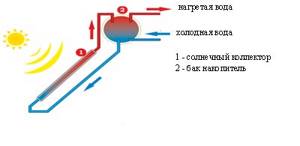
Rice. 1 Single-circuit solar installation with natural coolant circulation
Double-circuit solar systems (Fig. 2) assume the presence of two circuits.
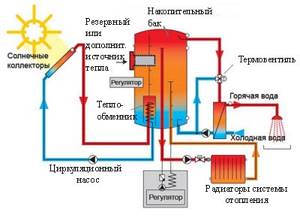
Rice. 2 Double-circuit solar installation with forced circulation for heating and hot water supply at home
In one, a coolant circulates, receiving energy in the collector (this is usually a non-freezing liquid) and, through a heat exchanger in the storage tank, giving it to water, which, when heated, enters the hot water supply or heating system of the house. Such systems have a slightly lower efficiency, but they can be operated at subzero outside temperatures, and the special coolant will not cause corrosion of the collector and the deposition of hardness salts does not occur, as in the case of using water from a well or borehole as a coolant.
Natural and forced coolant circulation
In solar systems with natural circulation (Fig. 1) , it is carried out due to convection, that is, due to the fact that warmer water has a lower density and rises, and in its place comes denser - cold. Most often, single-circuit systems operate according to this scheme. The advantage of such systems is their independence from the availability of electricity.
In systems with forced circulation (Fig. 2) , to maintain it, a circulation pump or, most often, a pumping station is used, which, in addition to the pump itself, includes automation, control and shut-off valves, an air valve and an expansion tank.
Double-circuit solar systems most often use this particular circulation method. Although forced circulation is more efficient than natural circulation, it requires electricity to operate the pump.
How much energy does the sun provide?
From the above it is clear that the solar system will work most effectively in the summer, when the sun is high and there is more sunlight.
In numbers, the energy of sunlight is characterized for the 52nd parallel and further south as: For June - about 600 W of energy per square meter. heated area in one hour.
In winter - almost ten times less. For December - 80 W/sq.m. in an hour.
In the off-season, something average - October, April - 300 - 350 W/sq.m.
But this, as indicated, is for southern latitudes. To the north there is less and less sun, and the energy received is much less.
What does this mean from a practical point of view - what can be heated?
Additional costs associated with operation
Using this does not imply any care or maintenance other than periodic cleaning of dirt and snow in winter (unless it thaws itself). However, there will be some associated costs:
- Repairs, everything that can be changed under warranty can be replaced by the manufacturer without any problems, it is important to buy an official dealer and have warranty documents.
- Electricity, very little of it is spent on the pump and controller. For the first one, you can install only 1 solar panel of 300 W and it will be quite enough (even without a battery system).
- Washing the coils will need to be done once every 5-7 years. It all depends on the quality of the water (if it is used as a coolant).
Tips for use
The operation of solar installations is carried out in accordance with the design features. The main task of the owner is to maintain cleanliness and remove dust or snow. In some cases , it is necessary to periodically change the position of the panels in accordance with seasonal changes in the location of the Sun. Repair or replacement of individual elements is carried out as the need arises; all work can be performed either independently or with the help of external specialists.
How to install a solar collector
You can install this system yourself. To do this, you need to understand the main principle of installation - maximum sunlight.
- We choose a place
. It should be on the sunny side. To do this, it is enough to observe for several days which place on the site the sun illuminates for as long as possible (you need to avoid getting into the shadows of trees or buildings). Select a starting point and an ending point, and direct the solar collector to the center of these points. This way we will get maximum coverage of thermal radiation. - Tilt angle
. This is an important stage of installation, on which its effectiveness depends. As a rule, such data is provided by the system manufacturer, but on average it is 45 degrees. It cannot be installed at a larger or smaller angle, as this will reduce the absorbing area. - We connect the rest of the equipment
. This is a pump group with a controller, a storage tank and connecting pipes. This is all connected according to the instructions. There is nothing complicated here, since the principle of the device is quite simple.
Installation recommendations
In this list we will list those points that installers must approach with full responsibility.
So, the following nuances are important:
- Area of the heliofield . That is, take care to check whether you purchased a sufficient number of panels. It also often happens that a store, in pursuit of profit, sells too many products.
- Collectors inclination angle.
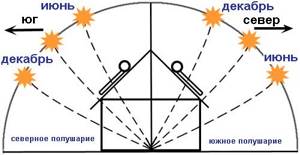
Initial data for calculating the optimal angle of inclination of the device
- Storage tank volume.
In all cases, the best solution would be to consult an independent specialist and then go to the store with these calculations.
This concludes our review, and we can move on to the results.
How power is calculated
Solar solar panels can have high performance when used in the private sector. To calculate the power of the equipment, it is necessary to take into account the absorption area of the collector, the amount of insolation for the region and the efficiency of the collector.
Eg:
• the collector occupies an area of 1 m2;
• the equipment has seven tubes, each absorption area is 0.15 m2.
Insolation 1173.7 (Moscow region) is multiplied by 0.15 m2 and again multiplied by 0.67 (efficiency factor). This turns out to be 117.95 kW•hour/sq. m, which in terms of daily value gives 0.325 kW•hour. On summer days with active sun, the system will generate 0.545 kWh.
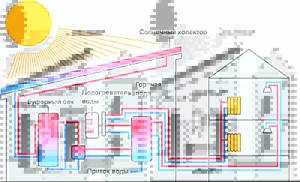
Installation cost for a private home
The cost of a solar system for a private home is influenced by the following factors:
• type of heating of the house, number of connections for hot water supply;
• complexity of equipment design;
• power;
• manufacturer.
For dachas and cottages, an installation with a capacity of 2 kWh will cost more than 165,000 rubles (basic equipment). If additional components and elements are required, costs will increase. A more powerful version of the solar system will cost over 270,000 rubles.
The average payback period for equipment is from 2 to 7 years, depending on the operating mode.

Installation features
In addition to the correct choice of equipment and competent design, qualified installation is required for flawless operation of the system. There are many subtleties, the use of which will help increase the service life of all collector elements.
The first nuance concerns the thermostatic valve, which serves as protection against burns. In standard heating systems, this element is rarely installed due to the fact that the temperature of hot water can be adjusted on the generator. Therefore, when designing a solar system, the valve is often forgotten. It is also possible to install a water heating limiter in the solar system regulator, but then the efficiency of the equipment will be significantly reduced. A tank heated to maximum temperature will provide hot water even on cloudy days.
In order for the valve to work correctly, it is installed a little further from the water heater. Close proximity provokes overheating of the unit, as a result of which hot water stops flowing into the pipeline.
The second nuance concerns the capacity of the hot water battery. It is installed in a spacious place. This is important for easy access to the tank for maintenance and repair. Often, a part of the room under the stairs or basement is selected for the tank. In this case, it is necessary to take into account the height of the ceiling. At the top of the water heater is a magnesium anode. To replace it, you will need a space above the tank of at least 60 cm. If the height does not allow for repair work, then an active electric anode should be installed at the installation stage of the system.
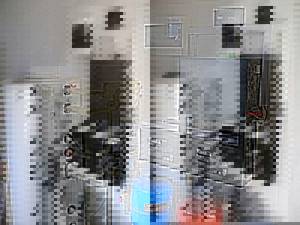
The third nuance concerns the installation of an expansion tank, which compensates for all the coolant displaced from the collectors during stagnation. This takes into account the thermal expansion of the liquid. Correct functioning of the tank ensures its correct location. Installation is carried out below the level of the pump group. If the container is placed above the pumps, the membrane will become vulnerable to high temperatures, causing an air bubble to form on it. It dries out the rubber, impairing its elasticity and other physical properties. This leads to rapid wear of the membrane.
The fourth nuance concerns the connection of the solar circuit to the battery tank. Due to the fact that heat always rushes upward, it is necessary to make a connection from below, creating a barrier to the warm flow. This is achieved by connecting pipes to the water heater, creating a so-called loop (thermal loop). If you ignore the recommendation, the temperature of the water in the tank will drop by at least 2-8 degrees overnight.
The fifth point concerns the check valve. In its absence, all the heat accumulated during the day in the solar circuit will dissipate through the collectors at night. To prevent wastage of resources, it is recommended to install a check valve in the lower connection of the battery tank.
Collectors from scrap materials
Assembling a solar collector for heating a house with your own hands is both cheaper and more interesting, because it can be made from various available materials.
From metal pipes
This assembly option is similar to the Stanilov manifold. When assembling a solar collector from copper pipes with your own hands, a radiator is welded from the pipes and placed in a wooden box lined with thermal insulation from the inside.
Copper pipes will be the most effective; aluminum pipes can also be used, but they are difficult to weld, but steel pipes are the most successful option.
Such a homemade collector should not be too large so that it is easy to assemble and install. The diameter of the pipes on solar collectors for radiator welding should be smaller than that of the pipes for coolant input and output.
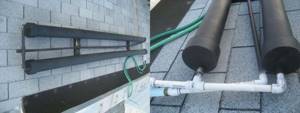
From plastic and metal-plastic pipes
How to make a solar collector with your own hands, having plastic pipes in your home arsenal? They are less effective as a heat storage device, but are several times cheaper than copper and do not corrode like steel.
The pipes are laid out in a box in a spiral and secured with clamps. They can be coated with black or selective paint for greater effectiveness.
You can experiment with pipe laying. Since pipes bend poorly, they can be laid not only in a spiral, but also in a zigzag. Among the advantages, plastic pipes can be easily and quickly soldered.
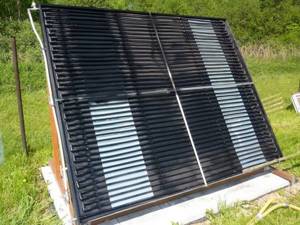
From the hose
To make a solar collector for a shower with your own hands, you will need a rubber hose. The water in it heats up very quickly, so it can also be used as a heat exchanger. This is the most economical option when making a collector yourself. A hose or polyethylene pipe is placed in a box and secured with clamps.
Since the hose is twisted in a spiral, natural circulation of water will not occur in it. To use a water storage tank in this system, it must be equipped with a circulation pump. If this is a summer cottage and little hot water is consumed, then the amount that flows into the pipe may be sufficient.
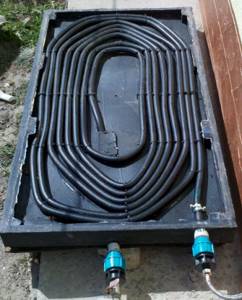
From cans
The coolant of a solar collector made from aluminum cans is air. The cans are connected to each other to form a pipe. To make a solar collector from beer cans, you need to cut off the bottom and top of each can, dock them together and glue them with sealant. The finished pipes are placed in a wooden box and covered with glass.
Basically, an air solar collector made from beer cans is used to eliminate dampness in the basement or to heat a greenhouse. Not only beer cans, but also plastic bottles can be used as a heat storage device.
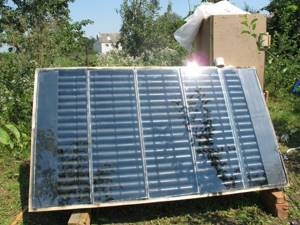
From the refrigerator
You can make your own solar water heating panels from an unusable refrigerator or the radiator of an old car. The condenser removed from the refrigerator must be rinsed thoroughly. Hot water obtained in this way is best used only for technical purposes.
Foil and a rubber mat are spread on the bottom of the box, then the capacitor is placed on them and secured. To do this, you can use belts, clamps, or the fastening with which it was attached in the refrigerator. To create pressure in the system, it would not hurt to install a pump or aqua chamber above the tank.
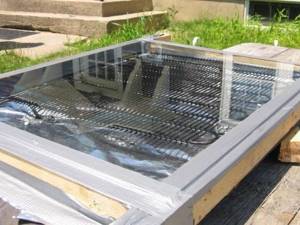
Shall we connect hot water supply?
In addition to heating, hot water supply can be connected to the solar collector system. To do this, let's calculate how much thermal energy you need to spend every day. The formula for calculating a solar collector for hot water supply is simple:
Pw = 1.163 x V x (T – t) / 24
Designations:
- Pw – amount of heat required to heat water;
- V – average volume of hot water consumed per day;
- T is the temperature to which the water needs to be heated;
- t is the temperature at which water enters the system.
To calculate the required number of additional collectors for hot water supply, divide this value by the performance of the solar collector P, obtained using the last formula.
Working area
The performance of the collector depends on the area of its working field and the degree of illumination. The area is determined based on summer load: the cost of hot water supply, maintaining the system to prevent condensation, and so on. You can do the calculations yourself: the easiest way to do this is to use the online service, indicating the number of inhabitants, the level of hot water consumption and the angle of inclination at which the panel can be placed.

For heating in winter, the heliofield—the working area of the apparatus—should be 2–2.5 times larger. A more accurate value can be determined by a specialist who takes into account the degree of insulation, the characteristics of the building, etc.
How to choose a solar installation for heating and hot water supply of a residential building?
Choosing a solar system is an important step that determines the efficiency of its operation and the investment of money. It is necessary to determine what kind of solar system is needed, price and size, type of solar collectors and other parameters of the complex.
It is necessary to select the design and configuration of the system, guided by the following criteria:
- level of solar activity in the region;
- the amount of thermal energy required to heat the house;
- prioritize solar energy in heating your home - either the solar system serves as the main system or as an addition.
Having decided on the main factors, you can begin to select the optimal design and volume of the system .
Up to 100 m2
Solar system for heating a house of 100 sq. m can serve as the main source of thermal energy . The main task will be the correct choice of solar collector design so that it is possible to receive the maximum amount of heat.
It is necessary to make a calculation taking into account the number of floors and configuration of the house, the number of sunny days per year, and the parameters of the coolant in the system . Solar system for heating a house of 100 sq. m., the price of which can range from 18 thousand rubles. up to 180 thousand rubles. and higher, is quite capable of providing heating for the house if all necessary conditions are met.
Up to 200 m2
For a house with an area of 200 m2, a solar system can only become an additional source of heating. Typically, the peak use of such installations occurs in the autumn and spring, when there is enough solar heat, but there is a need to heat the house.
There are practically no structural differences for such systems, only the storage tank is common with the main heating line of the house. Experts say that the use of solar power plants in the spring and autumn can reduce the load on heating systems by approximately 30-40%.
Thermal collectors for heating: advantages
The development of technology has led to the widespread use of solar systems for heating. The use of such systems reduces the thermal load on the building, and the contribution of solar energy becomes noticeable. Solar systems owe their popularity to the fact that they allow you to save on payments for using traditional energy sources.
The use of solar heating systems allows you to take care of the environment by reducing the level of harmful emissions.
The most common type of solar systems today are devices for daily thermal energy storage. Their disadvantage is the inability to do anything with excess heat in the summer. The solution is to follow the seasonal accumulation method.
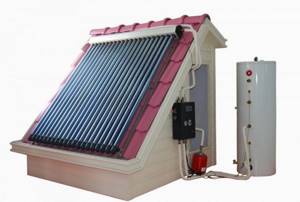
System advantages:
- Environmental friendliness;
- Cost-effective;
- Efficiency;
- Easy installation and use.
Solar water heating systems can be connected independently if you have a connection diagram and an understanding of the process. Installation can be done with the help of a professional technician, who will also help you choose an effective system. Installing such a system is economically justified, since electricity calculations will change significantly.


